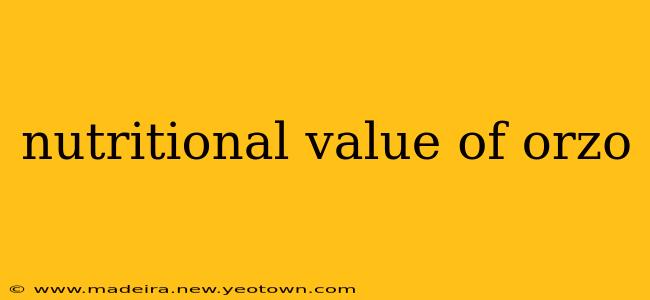Orzo. The tiny, rice-shaped pasta that's become a staple in kitchens worldwide. But beyond its versatility and delightful texture, lies a surprising nutritional profile. This isn't just a simple carb; orzo packs a punch when it comes to essential nutrients. Let's embark on a journey to uncover the hidden nutritional value of this culinary gem.
What is Orzo Made Of?
Before we dive into the nutritional specifics, it's essential to understand what orzo actually is. Orzo pasta is essentially small grains of pasta, typically made from semolina wheat, a coarse flour derived from durum wheat. This gives it a slightly nutty flavor and a pleasant chewiness that sets it apart from other pastas. However, you can also find orzo made from other grains like barley or even gluten-free options, subtly altering its nutritional composition.
What are the Nutritional Benefits of Orzo?
Orzo, like other whole-grain pasta options, is a good source of carbohydrates, providing energy for your body. But its benefits extend beyond that. A typical serving of cooked orzo offers a decent amount of:
- Carbohydrates: These are your body's primary energy source.
- Fiber: Crucial for digestive health, promoting regularity and preventing constipation.
- Protein: While not a primary protein source, it offers a modest amount to support muscle growth and repair.
- Iron: Essential for carrying oxygen throughout the body, helping prevent iron-deficiency anemia.
- Magnesium: Important for bone health, muscle function, and blood sugar control.
- Manganese: Plays a role in various metabolic processes and bone formation.
- Selenium: An antioxidant that protects cells from damage.
It's important to note that the precise nutritional content can vary based on the type of orzo (e.g., whole wheat versus refined), the brand, and the cooking method.
Is Orzo Good for Weight Loss?
This is a question many people ask. Orzo, being a carbohydrate, can contribute to weight gain if consumed in excessive amounts. However, it doesn't have to be a weight-loss enemy. The key lies in portion control and incorporating orzo into a balanced diet. Its fiber content promotes satiety, keeping you feeling full for longer and potentially reducing overall calorie intake. Furthermore, choosing whole-wheat orzo over refined versions boosts fiber content, further aiding in weight management.
Is Orzo Gluten-Free?
Not all orzo is gluten-free. Traditional orzo is made from semolina, a wheat product, making it unsuitable for people with celiac disease or gluten intolerance. However, many brands now offer gluten-free orzo made from alternative grains like rice or corn. Always check the packaging to ensure it meets your dietary needs.
How Many Calories are in Orzo?
The calorie count of orzo can fluctuate, depending on the serving size and whether it's cooked or dry. A typical 1-cup serving of cooked orzo contains around 200-230 calories. However, the addition of sauces, cheeses, or other ingredients will significantly increase the overall calorie count.
How to Incorporate Orzo into a Healthy Diet?
Orzo's versatility makes it easy to integrate into a healthy diet. It can be a fantastic base for salads, soups, or as a side dish. Consider these ideas:
- Orzo salad: Combine cooked orzo with fresh vegetables, herbs, and a light vinaigrette.
- Orzo soup: Add orzo to your favorite vegetable or chicken broth for a hearty and nutritious meal.
- Orzo with roasted vegetables: Roast your favorite vegetables and toss them with cooked orzo for a flavorful and satisfying dish.
By understanding the nutritional value of orzo and its place in a balanced diet, you can enjoy this delicious pasta without sacrificing your health goals. Remember to always check the nutrition facts on the packaging and practice mindful portion control.

